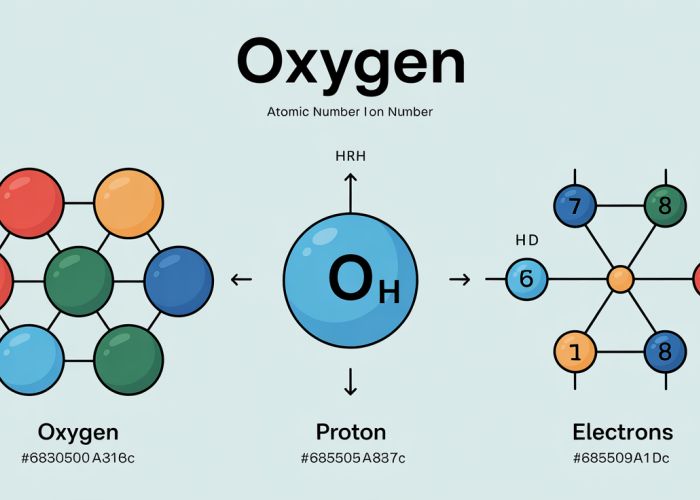The elemental nature of oxygen, a cornerstone of chemistry, hinges significantly on its atomic structure. Linus Pauling, a pioneer in understanding chemical bonding, emphasized the importance of electronegativity, a property closely tied to an atom’s nuclear charge. Specifically, the oxygen protons number, which dictates the positive charge in the nucleus, profoundly impacts its chemical behavior. Water (H₂O), perhaps the most vital compound on Earth, showcases the profound influence of oxygen’s properties, all rooted in its atomic number. Understanding oxygen’s protons number is fundamental to grasping not just its role in water, but also its participation in countless other chemical reactions vital for life and industrial processes. Therefore, exploring this fundamental aspect of oxygen opens doors to understanding a myriad of chemical phenomena and their implications.

Oxygen’s Protons: The # That Changes Everything!
Understanding the core properties of elements is fundamental to chemistry and numerous other scientific fields. This exploration focuses on oxygen, specifically on the profound significance of its proton number – its atomic number – and how this seemingly simple value dictates its behavior and role in the universe. The primary keyword we’ll be addressing is "oxygen protons number."
What are Protons and Why Do They Matter?
At the heart of every atom lies a nucleus, which contains positively charged particles called protons and neutral particles called neutrons. Electrons, negatively charged, orbit this nucleus. The number of protons defines what element an atom is. Changing the number of protons transforms the atom into a different element altogether.
Protons and Atomic Identity
The number of protons in an atom’s nucleus is known as its atomic number. It’s a unique identifier, like a fingerprint for each element.
- Each element has a unique atomic number.
- The atomic number determines the element’s position on the periodic table.
- Changing the number of protons changes the element itself.
Oxygen: A Deep Dive into its Proton Number
Oxygen’s atomic number, its "oxygen protons number," is 8. This means that every oxygen atom, by definition, contains 8 protons in its nucleus. This singular fact governs its chemical behavior, its role in life, and its abundance in the universe.
The Significance of Oxygen’s 8 Protons
The fact that oxygen has 8 protons has wide-ranging consequences:
-
Electron Configuration: To be electrically neutral, an oxygen atom must have 8 electrons orbiting its nucleus. The arrangement of these electrons (its electron configuration) determines how oxygen interacts with other atoms, forming chemical bonds. This electron configuration results in a high electronegativity, making it a strong oxidizing agent.
-
Bonding Behavior: Oxygen readily forms covalent bonds with other elements, sharing electrons to achieve a stable electron configuration. This allows it to form vital molecules like water (H₂O) and carbon dioxide (CO₂).
-
Isotopes: While all oxygen atoms have 8 protons, they can have varying numbers of neutrons. These variations are called isotopes. Common isotopes of oxygen include oxygen-16 (8 protons + 8 neutrons), oxygen-17 (8 protons + 9 neutrons), and oxygen-18 (8 protons + 10 neutrons). While they all behave chemically like oxygen, the difference in mass affects their physical properties and their prevalence in nature.
Isotope Protons Neutrons Atomic Mass Abundance (%) Oxygen-16 8 8 16 99.76 Oxygen-17 8 9 17 0.04 Oxygen-18 8 10 18 0.20 -
Oxidation: Oxygen is a powerful oxidizing agent because of its electron configuration. It readily accepts electrons from other substances, leading to oxidation reactions. This is critical for processes like respiration (where oxygen extracts energy from food) and combustion (burning).
Oxygen in the Cosmos
The abundance of oxygen in the universe is directly related to the processes that create it in stars. It is primarily created through nuclear fusion reactions in the cores of massive stars. These stars forge oxygen atoms from lighter elements like carbon and helium. The fact that a star can produce it is crucial to the existence of life.
Oxygen’s Protons: FAQs About the # That Changes Everything!
Here are some frequently asked questions to help clarify the role of protons and the atomic number of oxygen.
What exactly is the proton number, and why is it so important?
The proton number, also known as the atomic number, represents the number of protons found within the nucleus of an atom. For oxygen, this number is 8. It’s crucial because it uniquely identifies an element and dictates its chemical properties. Changing the oxygen protons number fundamentally changes the element.
How does the oxygen protons number define its properties?
The number of protons determines the element’s identity, its electron configuration (how electrons are arranged around the nucleus), and consequently, how it interacts with other atoms to form chemical bonds. For instance, oxygen, with its eight protons, readily forms bonds with two other atoms.
What happens if oxygen doesn’t have 8 protons?
If an atom had a different number of protons than 8, it wouldn’t be oxygen. An atom with 7 protons is nitrogen, and an atom with 9 protons is fluorine. Altering the oxygen protons number completely changes the element and its associated characteristics.
What’s the difference between protons, neutrons, and electrons in an oxygen atom?
Protons are positively charged particles in the nucleus; their number defines the element. Neutrons are neutral particles also in the nucleus; their number can vary, creating isotopes. Electrons are negatively charged particles orbiting the nucleus and dictate how the atom interacts with other atoms, with the amount of them usually being the same as the oxygen protons number.
So, that’s the scoop on oxygen protons number! Hope you found it insightful and maybe even a little mind-blowing. Now go forth and impress your friends with your newfound oxygen knowledge!